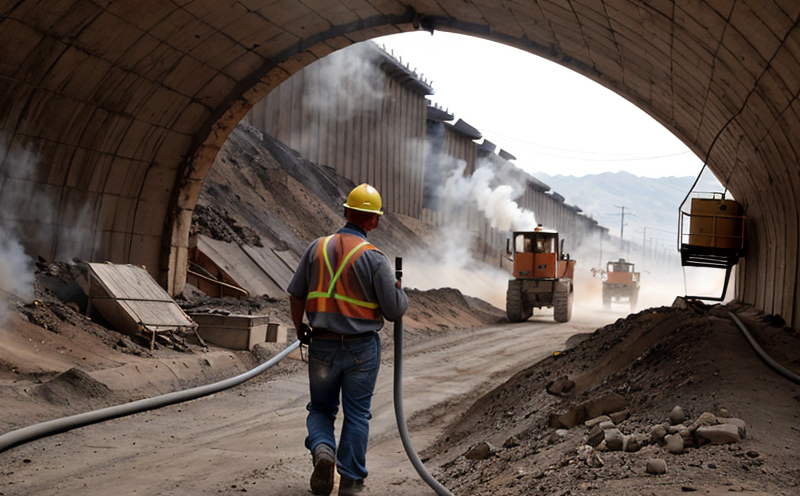DIN 33903 Measurement of Respirable Quartz in Mines Testing
The DIN 33903 standard is a crucial benchmark for ensuring occupational health and safety within mining environments. It focuses on the measurement of respirable quartz, which is one of the primary causes of silicosis, a serious lung disease that affects miners. This test ensures that air quality in mines meets stringent regulatory requirements aimed at protecting workers' health.
Respirable quartz refers to the fraction of crystalline silica that can be inhaled and deposited into the alveoli of the lungs. The standard outlines detailed procedures for sampling, analysis, and interpretation of results. It is widely recognized as a reliable method for quantifying respirable quartz levels, which are critical for assessing the risk of silicosis among miners.
The process begins with proper sampling techniques to ensure that the collected samples accurately represent the air quality in the mine. After collection, these samples undergo rigorous analysis using advanced analytical instruments such as scanning electron microscopy (SEM) coupled with energy-dispersive X-ray spectroscopy (EDX). This combination of technologies allows for precise quantification and identification of respirable quartz particles.
The DIN 33903 standard also provides stringent acceptance criteria that define the permissible limits of respirable quartz in mine air. Compliance with these standards is mandatory to ensure occupational health and safety, as excessive exposure can lead to severe respiratory issues. The standard's comprehensive approach ensures that mining companies can maintain a safe working environment for their employees.
Implementing DIN 33903 involves several key steps: initial assessment of the mine’s air quality, regular sampling and analysis, and continuous monitoring to ensure compliance with regulatory standards. By following these procedures, mines can effectively manage the risk of silicosis among their workforce. The standard also emphasizes the importance of training employees on the risks associated with respirable quartz and the measures they can take to mitigate those risks.
The significance of DIN 33903 cannot be overstated, especially in light of increasing awareness about occupational health hazards. Mining companies that adhere to this standard demonstrate a commitment to their employees' well-being and regulatory compliance. By investing in robust testing protocols like DIN 33903, mines can protect their workforce from the severe health impacts of respirable quartz exposure.
The standard also underscores the need for ongoing monitoring and adaptation as mining practices evolve. As new technologies emerge and regulatory landscapes change, adhering to standards such as DIN 33903 ensures that mining operations remain at the forefront of occupational safety and environmental responsibility.
Benefits
Ensures strict adherence to international occupational health standards.
Provides reliable data for making informed decisions about air quality in mines.
Reduces the risk of work-related illnesses such as silicosis among miners.
Aids in maintaining compliance with stringent regulatory requirements.
Enhances a company's reputation for occupational safety and health.
Eurolab Advantages
At Eurolab, we pride ourselves on providing comprehensive testing services that go beyond compliance. Our team of experts ensures that each DIN 33903 test is conducted with the highest level of precision and accuracy. We utilize state-of-the-art equipment and follow international standards to deliver reliable results.
We offer flexible scheduling options for sampling, ensuring that your air quality testing does not disrupt your mining operations. Our dedicated staff provides thorough analysis and detailed reports, making it easier for you to understand the results and take necessary actions.
Moreover, Eurolab's commitment to excellence extends beyond just testing services. We also offer training programs on respiratory protection and dust control strategies tailored specifically for the mining industry. By investing in these resources, we help mining companies stay ahead of regulatory changes and best practices.
Use Cases and Application Examples
DIN 33903 is applicable across various scenarios within the mining sector:
Initial site assessments to establish baseline air quality levels.
Routine monitoring of air quality during regular operations.
Post-incident analysis following any dust-related incidents or accidents.
By incorporating DIN 33903 into their routine practices, mining companies can ensure that they are always prepared to meet regulatory requirements and maintain a safe working environment for all employees. Eurolab's expertise in this area ensures that each testing process is conducted efficiently and effectively.





